Study of the Mining Waste in the Production of Calcined Aggregate for Use in Pavement
Abstract
:1. Introduction
2. Materials and Methods
- First stage: physical, mechanical, and mineralogical characterization tests on the materials involved in synthetic aggregate production (pure clay, mining waste and clay/waste), such as Atterberg limits for liquidity (DNER-ME 122 [27]) and plasticity (NBR 7180 [28]), particle size analysis (DNER-ME 051 [29]), real density (DNER-ME 093 [30]), loss of mass after boiling (DNER-ME 225 [31]), expedited selection using the boiling method (DNER-ME 223 [32]), energy dispersive spectroscopy (EDS), and X-Ray Diffraction (XRD).
- Second stage: Aggregate production, with moulding carried out using an electric pug mill and calcination in a muffle-type furnace, with temperatures ranging from 800 °C to 1100 °C. The aggregates were divided into two sample groups: Group A represents aggregates produced from pure clay, and Group M represents aggregates produced from the clay/waste mixture (15% by weight of mining waste).
- Third stage: The following tests were conducted on calcined aggregates: unit weight (DNER-ME 152 [33]), loss of mass after boiling (DNER-ME 225 [31]), Los Angeles abrasion resistance (DNER-ME 222 [34]), shock loss of mass in the Treton apparatus (DNER-ME 399 [35]), and water absorption and density (DNER-ME 081 [36]).
Preparation of Samples
3. Results and Discussion
3.1. Physical and Mineralogical Characterization
3.2. Characterization of the Produced Synthetic Aggregates
3.2.1. Water Absorption Test
3.2.2. Loss Mass Test in the Treton Apparatus
3.2.3. Boiling Mass Loss Test
3.2.4. Mass Unit Test
3.2.5. Los Angeles Abrasion Test
3.2.6. Real and Bulk Density
3.2.7. X-ray Diffraction (XRD)
3.3. Analysis of the Technical Feasibility of Using the Synthetic Aggregate Produced
4. Conclusions
Suggestions for Future Work and Recommendations of Research
- Evaluate the environmental aspects of using these aggregates in pavement layers.
- Assess potential environmental impacts due to the eventual release of toxic components resulting from material degradation over time.
- Study the expansion of the aggregate before conducting any experiments.
Author Contributions
Funding
Data Availability Statement
Acknowledgments
Conflicts of Interest
References
- Queiroz, H.M.; Nóbrega, G.N.; Ferreira, T.O.; Almeida, L.S.; Romero, T.B.; Santaella, S.T.; Bernardino, A.F.; Otero, X.L. The Samarco mine tailing disaster: A possible time-bomb for heavy metals contamination? Sci. Total Environ. 2018, 637, 498–506. [Google Scholar] [CrossRef] [PubMed]
- Thompson, F.; de Oliveira, B.C.; Cordeiro, M.C.; Masi, B.P.; Rangel, T.P.; Paz, P.; Freitas, T.; Lopes, G.; Silva, B.S.; Cabral, A.S. Severe impacts of the Brumadinho dam failure (Minas Gerais, Brazil) on the water quality of the Paraopeba River. Sci. Total Environ. 2020, 705, 135914. [Google Scholar] [CrossRef] [PubMed]
- Rybak, J.; Gorbatyuk, S.M.; Bujanovna-Syuryun, K.C.; Khairutdinov, A.M.; Tyulyaeva, Y.S.; Makarov, P.S. Utilization of Mineral Waste: A Method for Expanding the Mineral Resource Base of a Mining and Smelting Company. Metallurgist 2021, 64, 851–861. [Google Scholar] [CrossRef]
- National Mining Agency—ANM. National Dam Safety Information System. Available online: https://www.gov.br/anm/pt-br (accessed on 30 May 2023). (In Portuguese)
- Porto, T.B.; Torres, A.C.A.; Gomes, R.C. Behavior of reinjectable and prestressed anchors in soil masses: Construction case study in Congonhas—Brazil (Case Study). Soil Rocks 2017, 40, 177–186. [Google Scholar] [CrossRef]
- Apaza, F.R.; Guimarães, A.C.R.; Vivoni, A.M.; Schroder, R. Evaluation of the performance of iron ore waste as potential recycled aggregate for micro-surfacing type cold asphalt mixtures. Constr. Build. Mater. 2021, 266, 121020. [Google Scholar] [CrossRef]
- Rybak, J.; Kongar‐Syuryun, C.; Tyulyaeva, Y.; Khayrutdinov, A.M. Creation of Backfill Materials Based on Industrial Waste. Minerals 2021, 11, 739. [Google Scholar] [CrossRef]
- Rybak, J.; Adigamov, A.; Kongar‐Syuryun, C.; Khayrutdinov, M.; Tyulyaeva, Y. Renewable‐Resource Technologies in Mining and Metallurgical Enterprises Providing Environmental Safety. Minerals 2021, 11, 1145. [Google Scholar] [CrossRef]
- Lima, L.M.K. Retroanalysis of the Formation of An Aerial Method-Constructed Fine Mining Waste Deposit. Master’s Dissertation, Federal University of Ouro Preto, Ouro Preto, MG, Brazil, 2006. Available online: http://www.repositorio.ufop.br/handle/123456789/2246 (accessed on 15 May 2023). (In Portuguese).
- Sultan, H.A. Stabilized Copper Mill Tailings for Highway Construction. Transp. Res. Rec. 1979, 734, 15–19. [Google Scholar]
- Segui, P.; Safhi, A.e.M.; Amrani, M.; Benzaazoua, M. Mining Wastes as Road Construction Material: A Review. Minerals 2023, 13, 90. [Google Scholar] [CrossRef]
- Wellmer, F.W.; Becker-Platen, J. Sustainable development and the exploitation of mineral and energy resources: A review. Int. J. Earth Sci. 2002, 91, 723–745. [Google Scholar] [CrossRef]
- Phillips, J. Evaluating the level and nature of sustainable development of a mining operation: A new approach using the ideas of coupled environment-human systems. Int. J. Min. Miner. Eng. 2010, 2, 215–238. [Google Scholar] [CrossRef]
- Fan, X.; Li, Z.; Zhang, W.; Jin, H.; Liu, J.; Xing, F.; Tang, L. New applications of municipal solid waste incineration bottom ash (MSWIBA) and calcined clay in construction: Preparation and use of an eco-friendly artificial aggregate. Constr. Build. Mater. 2023, 387, 131629. [Google Scholar] [CrossRef]
- Ghazali, N.; Muthusamy, K.; Abdullah, N.A.; Asri, M.I.M.; Jamaludin, N.F.A. Effect of coal bottom ash as partial sand replacement for lightweight aggregate concrete. Key Eng. Mater. 2022, 912, 119–125. [Google Scholar] [CrossRef]
- Cabral, E.M.; Sá, R.J.; Vieira, R.K.; Vasconcelos, R.P. Utilization of ceramic masses in the production of synthetic calcined clay aggregate for use in concrete. Ceramics 2008, 54, 404–410. (In Portuguese) [Google Scholar] [CrossRef]
- Cabral, G.L.L. Utilization of Calcined Clay Artificial Aggregate in Pavement Construction and Technology Enhancement. Ph.D. Thesis, Federal University of Rio de Janeiro, Rio de Janeiro, Brazil, 2011. Available online: http://www.coc.ufrj.br/pt/teses-de-doutorado/155-2011/1251-gustavo-da-luz-lima-cabral (accessed on 13 June 2023). (In Portuguese).
- Batista, F.G.S. Physical and Mechanistic Characterization of Calcined Clay Aggregates Produced from Fine Soils of BR-163/PA. Master’s Thesis, Military Institute of Engineering, Rio de Janeiro, Brazil, 2004. (In Portuguese). [Google Scholar]
- Silva, C.L.; Frota, H.O.; Frota, C.A. Sintered calcined clay as an alternative coarse aggregate for asphalt pavement construction. Open J. Civ. Eng. 2015, 5, 281–288. [Google Scholar] [CrossRef]
- Santos, M.G.R. Study of Synthetic Calcinated Clay Aggregates Behavior for Use in Pavement Asphalt for Manaus. Master’s Thesis, University of Brasília, Brasília, Brazil, 2007. Available online: https://repositorio.unb.br/handle/10482/2919 (accessed on 25 June 2023). (In Portuguese).
- Campelo, N.S.; Campos, A.M.L.S.; Aragão, A.F. Comparative analysis of asphalt concrete mixtures employing pebbles and synthetic coarse aggregate of calcined clay in the Amazon region. Int. J. Pavement Eng. 2019, 20, 507–518. [Google Scholar] [CrossRef]
- Barbosa, V.H.R.; Marques, M.E.S.; Guimarães, A.C.R.; Silveira, V.L. Study of two soils from Acre to produce calcined clay aggregates and mixtures for pavement bases. In Proceedings of the 32nd Congress of Research and Teaching in Transportation of ANPET, Gramado, Brazil, 10–14 November 2018. (In Portuguese). [Google Scholar]
- Cabral, G.L.L. Production methodology and use of calcined clay aggregates for pavement. Master’s Thesis, Military Institute of Engineering, Rio de Janeiro, Brazil, 2005. (In Portuguese). [Google Scholar]
- Yinfei, D.; Pusheng, L.; Jiacheng, W.; Hancheng, D.; Hao, W.; Yingtao, L. Effect of lightweight aggregate gradation on latent heat storage capacity of asphalt mixture for cooling asphalt pavement. Constr. Build. Mater. 2020, 250, 118849. [Google Scholar] [CrossRef]
- Khan, A.; Mrawira, D.; Hildebrand, E.E. Use of lightweight aggregate to mitigate frost damage in flexible pavements. Int. J. Pavement Eng. 2009, 10, 329–339. [Google Scholar] [CrossRef]
- Agrawal, Y.; Gupta, T.; Sharma, R.; Panwar, N.L.; Siddique, S. A comprehensive review on the performance of structural lightweight aggregate concrete for sustainable construction. Constr. Mater. 2021, 1, 39–62. [Google Scholar] [CrossRef]
- ME 122/94. Soils—Determination of Liquid Limit—Reference Method and Expedited Method. Department of National Roads and Highways—DNIT: Rio de Janeiro, Brazil, 1994. (In Portuguese)
- NBR 7180/16. Soil—Determination of Plasticity Limit. Brazilian Association of Technical Standards—ABNT: Rio de Janeiro, Brazil, 2016. (In Portuguese)
- ME 051/94. Soils—Particle Size Analysis. Department of National Roads and Highways—DNIT: Rio de Janeiro, Brazil, 1994. (In Portuguese)
- ME 093/94. Soils—Determination of Real Density. Department of National Roads and Highways—DNIT: Rio de Janeiro, Brazil, 1994. (In Portuguese)
- ME 225/94. Synthetic Aggregate of Calcined Clay—Determination of Mass Loss after Boiling. Department of National Roads and Highways—DNIT: Rio de Janeiro, Brazil, 1994. (In Portuguese)
- ME 223/94. Clays for the Production of Clay Synthetic Aggregate—Expedited Selection through the Boilling Process. Department of National Roads and Highways—DNIT: Rio de Janeiro, Brazil, 1994. (In Portuguese)
- ME 152/95. Aggregates in Loose State—Determination of Bulk Density. Department of National Roads and Highways—DNIT: Rio de Janeiro, Brazil, 1995. (In Portuguese)
- ME 222/94. Synthetic Aggregate Manufactured with Clay—Abrasion Test. Department of National Roads and Highways—DNIT: Rio de Janeiro, Brazil, 1994. (In Portuguese)
- ME 399/99. Aggregates—Determination of Shock Loss Using the Treton Apparatus. Department of National Roads and Highways—DNIT: Rio de Janeiro, Brazil, 1999. (In Portuguese)
- ME 081/98. Aggregates—Determination of Absorption and Bulk Density of Coarse Aggregate. Department of National Roads and Highways—DNIT: Rio de Janeiro, Brazil, 1998. (In Portuguese)
- EM 230/94. Coarse Synthetic Aggregates of Calcined Clay. Department of National Roads and Highways—DNIT: Rio de Janeiro, Brazil, 1994. (In Portuguese)
- ES 227/89. Coarse Synthetic Aggregates of Calcined Clay—Use in Road Works. National Department of Highways and Roads—DNER: Rio de Janeiro, Brazil, 1989.
- Hu, L.; Wu, H.; Zhang, L.; Zhang, P.; Wen, Q. Geotechnical Properties of Mine Tailings. J. Mater. Civ. Eng. 2017, 29, 04016220. [Google Scholar] [CrossRef]
- Bastos, L.A.C.; Silva, G.C.; Mendes, J.C.; Peixoto, R.A.F. Using Iron Ore Tailings from Tailing Dams as Road Material. J. Mater. Civ. Eng. 2016, 28, 04016102. [Google Scholar] [CrossRef]
- Pracidelli, S.; Melchiades, F.G. Importance of the granulometric composition of clay masses for red ceramics. Ind. Ceram. 1997, 2, 31–35. (In Portuguese) [Google Scholar]
- Ledbetter, W.B.; Moore, W.M.; Gallaway, B.M. A Synthetic Coarse Aggregate Classification System-Final Report; Research Report No 81-15. Synthetic Aggregate Research. Study 2-8-65-81; Texas Transportation Institute: Arlington, TX, USA, 1971. [Google Scholar]
- Ahmed, A.A.; Abouzeid, A.Z.M. Potential use of phosphate wastes as aggregates in road construction. J. Eng. Sci. 2009, 37, 413–422. [Google Scholar] [CrossRef]
- Ahmed, A.A.M.; Abdel Kareem, K.H.; Altohamy, A.M.; Rizk, S.A.M. Potential Use of Mines and Quarries SolidWaste in Road Construction and as Replacement Soil Under Foundations. J. Eng. Sci. 2014, 42, 1094–1105. [Google Scholar] [CrossRef]
- Amrani, M.; Taha, Y.; Kchikach, A.; Benzaazoua, M.; Hakkou, R. Valorization of Phosphate MineWaste Rocks as Materials for Road Construction. Minerals 2019, 9, 237. [Google Scholar] [CrossRef]
- P18-573; Aggregates. Los Angeles Test—Granulate. Los Angeles Pruefung; Association Française de Normalisation: Paris, France, 1990.
- Baucia, J.A., Jr.; Koshimizu, L.; Gibertoni, C.; Morelli, M.R. Study of alternative fluxes for use in porcelain formulations. Ceramics 2010, 56, 262–272. (In Portuguese) [Google Scholar] [CrossRef]
- Santos, H.S.; Kiyohara, P.; Coelho, A.C.V.; Santos, P.S. Study by electron microscopy of transformations during firing of highly alumina Brazilian clays. Ceramics 2006, 52, 125–137. [Google Scholar] [CrossRef]
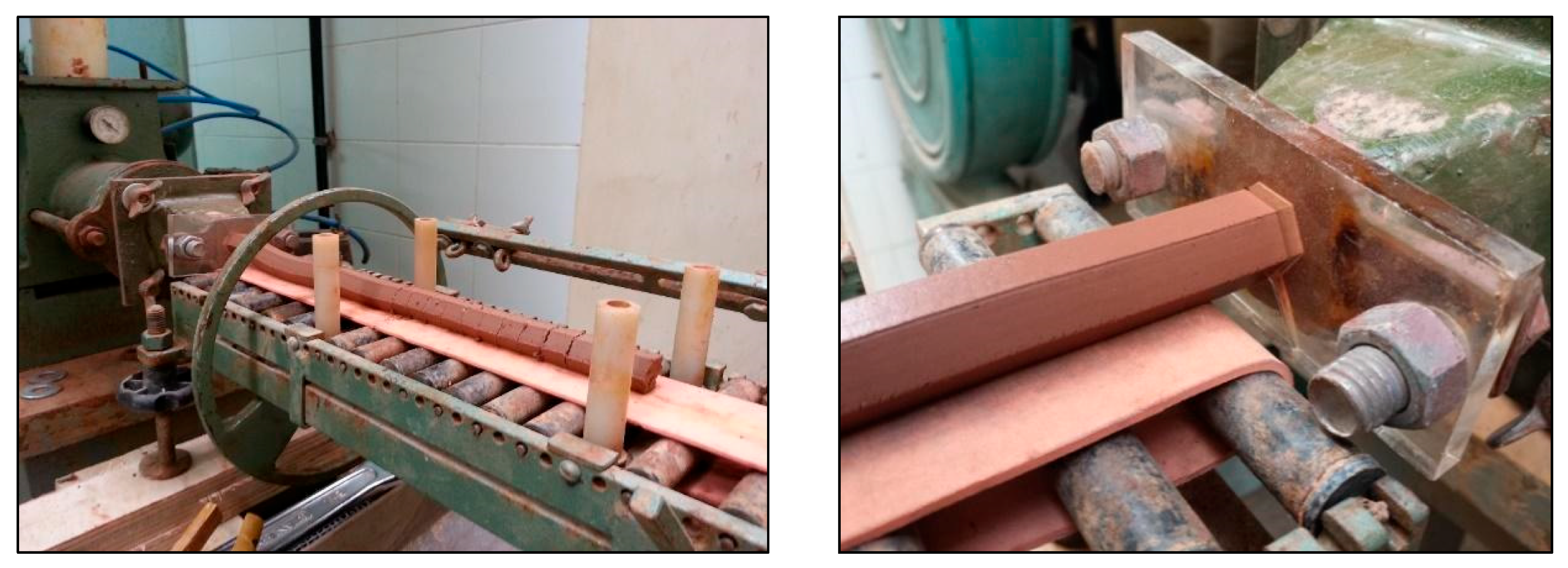
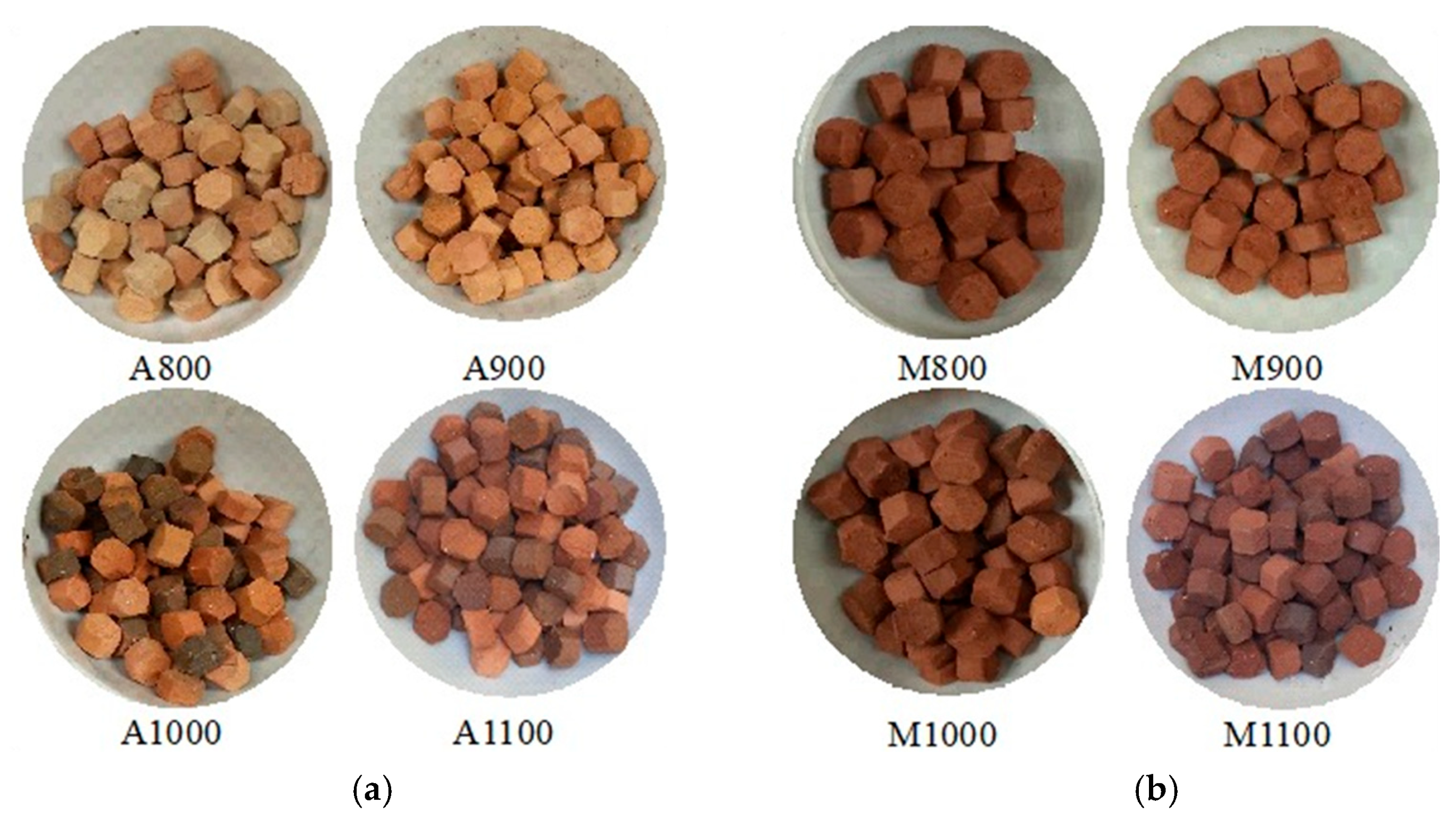


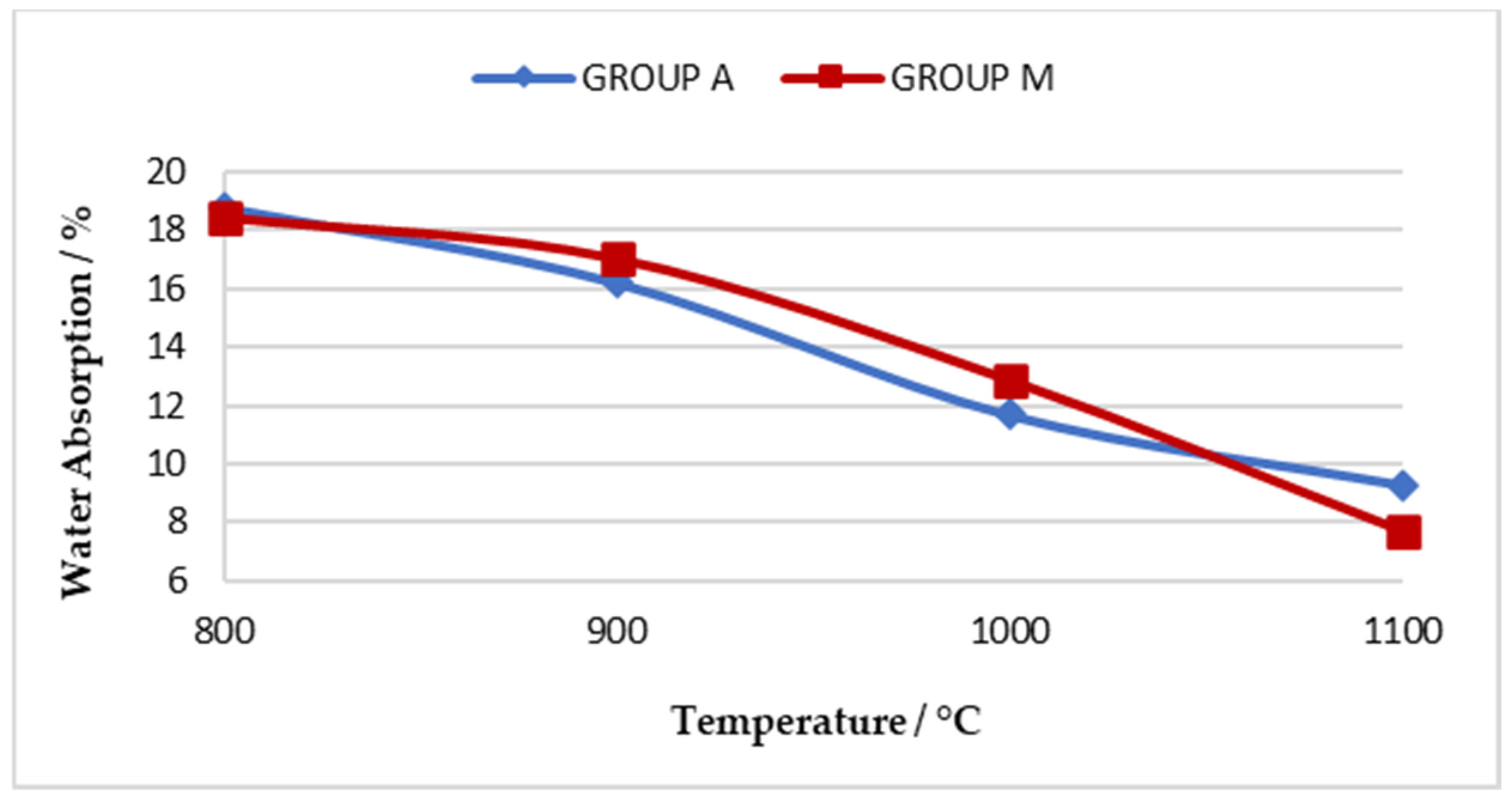
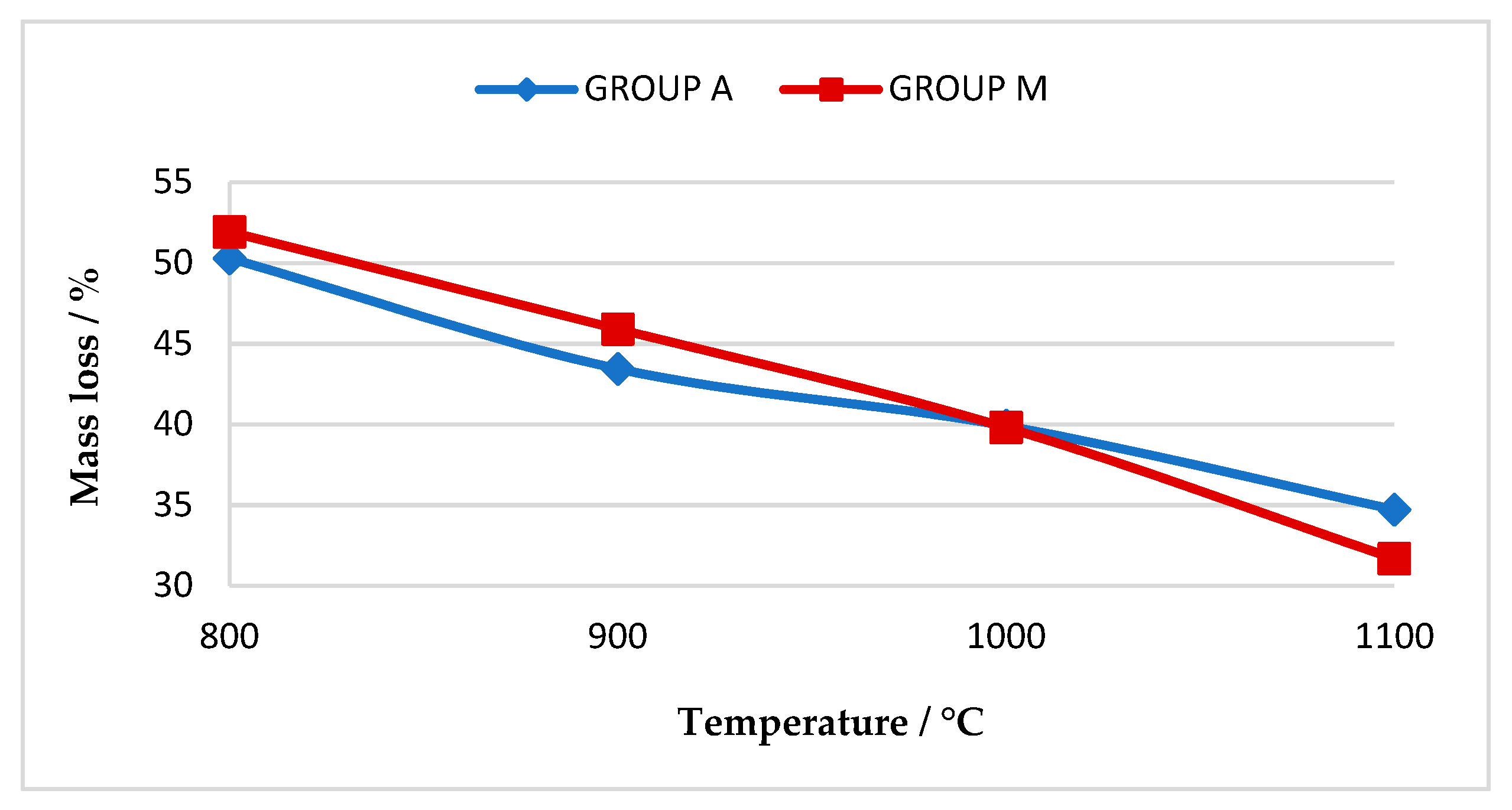
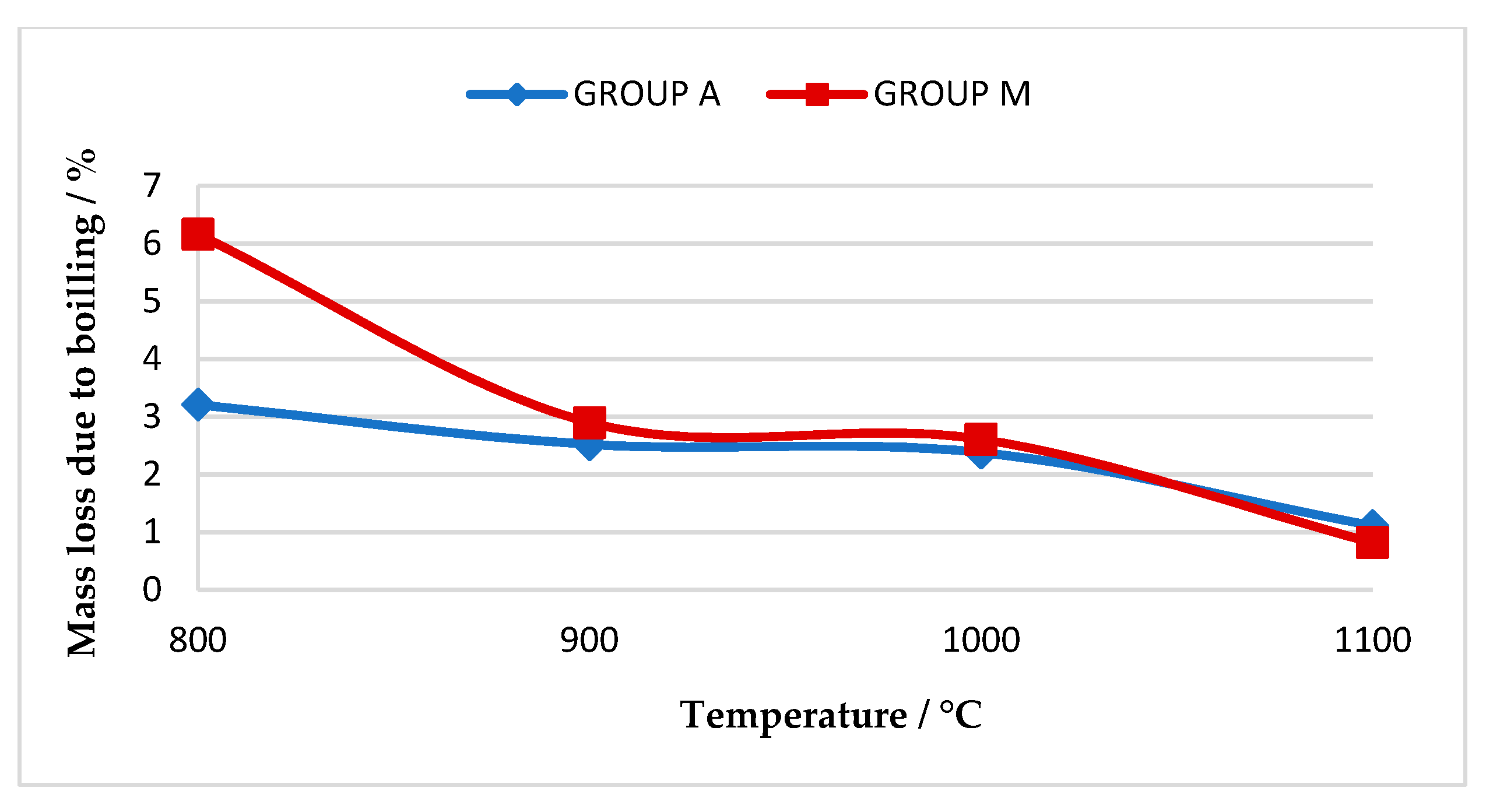


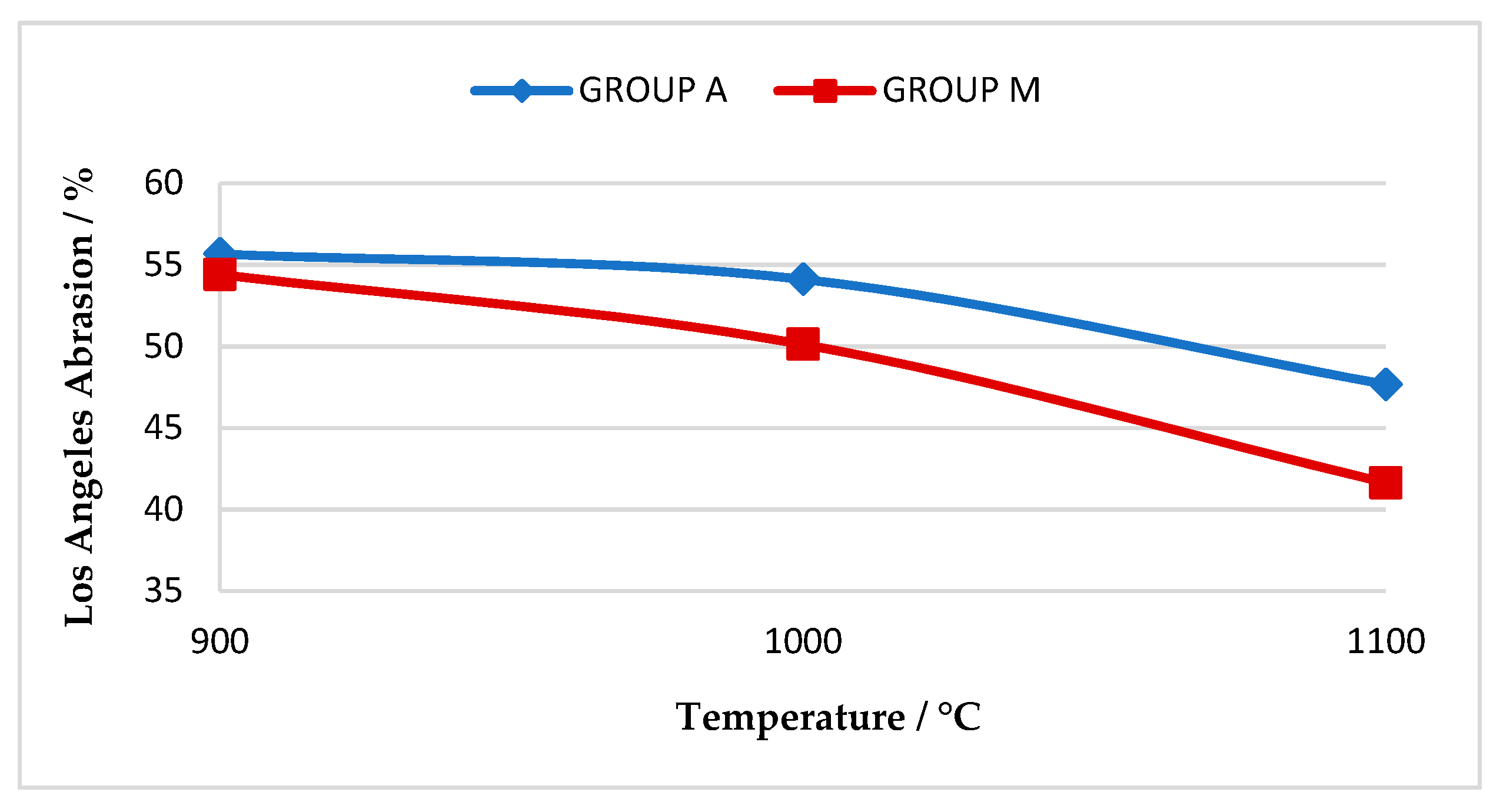

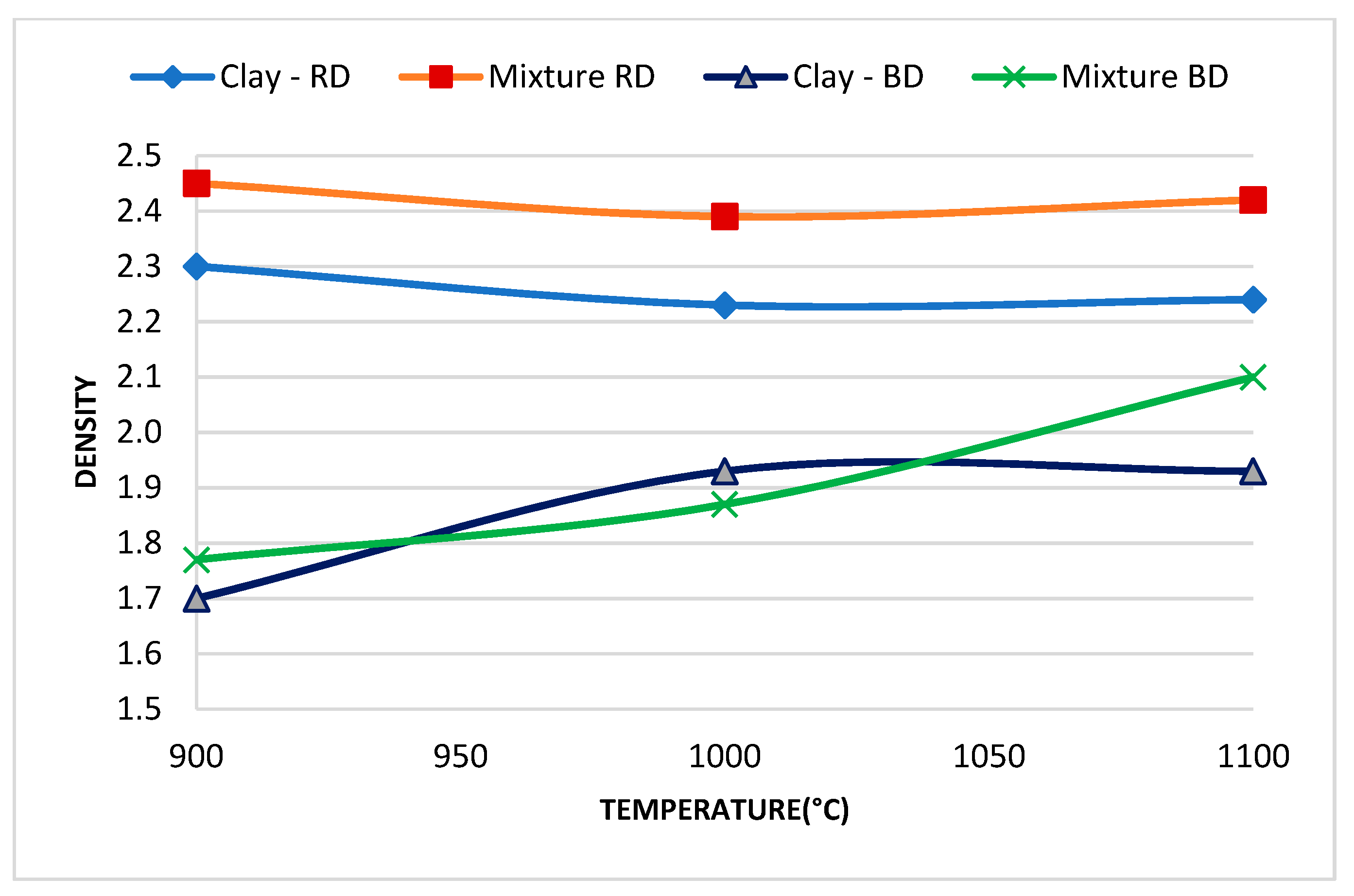
| Classification | Unit Weight | Loss of Mass after Boiling (%) | Los Angeles Abrasion (%) | ||
|---|---|---|---|---|---|
| Class | Group | Max. | Min. | Max. | Max. |
| I | A | 0.88 | 0.56 | 6 | 35 |
| B | 0.88 | 0.56 | 6 | 40 | |
| C | 0.88 | 0.56 | 10 | 45 | |
| II | A | 0.88 | 6 | 35 | |
| B | 0.88 | 6 | 40 | ||
| C | 0.88 | 10 | 45 | ||
| Nature of the Service | Class and Group |
|---|---|
| Surface treatments | IA |
| Asphalt concrete overlay | IA, IIA |
| Asphalt concrete base | IA, IB, IC, IIA, IIB, IIC |
| Exposed lightweight Portland cement concrete structures | IA |
| Portland cement concrete pavement | IA, AB |
| Portland cement concrete base | IA, IB, IC, IIA, IIB |
| Materials for flexible pavement | IA, IB, IC, IIA, IIB, IIC |
| Test | Waste | Clay | Mixture |
|---|---|---|---|
| Liquid Limit (%) | 20 | 39 | 20.5 |
| Plastic Limit (%) | 14 | 22 | 32.6 |
| Plasticity Index (%) | 6 | 17 | 12.1 |
| Real Density (g/cm3) | 3.93 | 2.6 | 2.8 |
| Sample | Present Minerals |
|---|---|
| Soil | Kaolinite |
| Orthoclase | |
| Halloysite | |
| Chromium Chlorite | |
| Quartz | |
| Waste | Quartz |
| Kaolinite | |
| Haematite | |
| Goethite | |
| Mixture | Quartz |
| Kaolinite | |
| Muscovite | |
| Microcline |
| Sample | Real Density | Bulk Density |
|---|---|---|
| A900 | 2.30 | 1.70 |
| A1000 | 2.23 | 1.93 |
| A1100 | 2.24 | 1.93 |
| M900 | 2.45 | 1.77 |
| M1000 | 2.39 | 1.87 |
| M1100 | 2.42 | 2.10 |
| Group | Sample | Present Minerals | Crystalline Systems | |
|---|---|---|---|---|
| A | A800 | Quartz | SiO2 | Hexagonal |
| Haematite | Fe2O3 | Rhombohedral H. Axes | ||
| Halloysite | OH8Al2Si2O3 | Monoclinic | ||
| Goethite | FeO(OH) | Orthorhombic | ||
| Albite | NaAlSi3O8 | Triclinic | ||
| A900 | Quartz | SiO2 | Hexagonal | |
| Haematite | Fe2O3 | Rhombohedral H. Axes | ||
| Halloysite | OH4Al2Si2O5 | Hexagonal | ||
| Orthoclase | K0.58NaO0.42AlSi3O8 | Triclinic | ||
| A1000 | Quartz | SiO2 | Hexagonal | |
| Orthoclase | KAlSi3O8 | Monoclinic | ||
| A1100 | Quartz | SiO2 | - | |
| Mullite | Al(Al69Si1220) | - | ||
| M | M800 | Quartz | SiO2 | Hexagonal |
| Hornblende | (Na,K)0.72(Ca,Fe)2 (Mg,Fe,Al)5(Si,Al)8O22 OH2 | Monoclinic | ||
| Halloysite | OH8Al2Si2O3 | Hexagonal | ||
| Microcline | (K0.95Na0.05)AlSi3O8 | Triclinic | ||
| M900 | Quartz | SiO2 | Hexagonal | |
| Hornblende | (Na,K)0.72(Ca,Fe)2 (Mg,Fe,Al)5(Si,Al)8 O22 OH2 | Monoclinic | ||
| Halloysite | OH8Al2Si2O3 | Monoclinic | ||
| Orthoclase | K0.59Ba0.19Na0.22(Al1.18Si2.82O8) | Monoclinic | ||
| M1000 | Quartz | SiO2 | Hexagonal | |
| Hornblende | (Na,K)0.72(Ca,Fe)2 (Mg,Fe,Al)5(Si,Al)8O22 OH2 | Monoclinic | ||
| Haematite | Fe2O3 | Rhombohedral H. Axes | ||
| Orthoclase | K0.59Ba0.19Na0.22(Al1.18Si2.82O8) | Monoclinic | ||
| M1100 | Quartz | SiO2 | - | |
| Mullite | Al(Al69Si1220) | - | ||
| Group | Sample | Absorption | Treton Shock Loss | Loss of Mass after Boiling | Unit Weight (g/cm3) | Los Angeles Abrasion | |||
|---|---|---|---|---|---|---|---|---|---|
| Res. | Standard | Res. | Standard | Res. | Standard | ||||
| A | A800 | 18.81% | 50.3% | 3.21% | <10% | - | - | - | - |
| A900 | 16.21% | 43.44% | 2.52% | <10% | 0.99 | > 0.88 | 55.66% | <45% | |
| A1000 | 11.68% | 39.91% | 2.38% | <10% | 1.03 | > 0.88 | 54.11% | <45% | |
| A1100 | 9.28% | 34.71% | 1.1% | <10% | 1.07 | > 0.88 | 47.66% | <45% | |
| M | M800 | 18.46% | 51.93% | 6.16% | <10% | - | - | - | |
| M900 | 17.04% | 45.91% | 2.9% | <10% | 1.02 | > 0.88 | 54.4% | <45% | |
| M1000 | 12.86% | 39.81% | 2.61% | <10% | 1.10 | > 0.88 | 50.12% | <45% | |
| M1100 | 7.68% | 31.67% | 0.82% | <10% | 1.16 | > 0.88 | 41.63% | <45% | |
Disclaimer/Publisher’s Note: The statements, opinions and data contained in all publications are solely those of the individual author(s) and contributor(s) and not of MDPI and/or the editor(s). MDPI and/or the editor(s) disclaim responsibility for any injury to people or property resulting from any ideas, methods, instructions or products referred to in the content. |
© 2023 by the authors. Licensee MDPI, Basel, Switzerland. This article is an open access article distributed under the terms and conditions of the Creative Commons Attribution (CC BY) license (https://creativecommons.org/licenses/by/4.0/).
Share and Cite
Friber, M.A.; Guimarães, A.C.R.; Martins, C.A.; Soares, J.S. Study of the Mining Waste in the Production of Calcined Aggregate for Use in Pavement. Minerals 2023, 13, 1543. https://doi.org/10.3390/min13121543
Friber MA, Guimarães ACR, Martins CA, Soares JS. Study of the Mining Waste in the Production of Calcined Aggregate for Use in Pavement. Minerals. 2023; 13(12):1543. https://doi.org/10.3390/min13121543
Chicago/Turabian StyleFriber, Marcio Aurelio, Antonio Carlos Rodrigues Guimarães, Camila Antunes Martins, and Jefferson Santos Soares. 2023. "Study of the Mining Waste in the Production of Calcined Aggregate for Use in Pavement" Minerals 13, no. 12: 1543. https://doi.org/10.3390/min13121543
APA StyleFriber, M. A., Guimarães, A. C. R., Martins, C. A., & Soares, J. S. (2023). Study of the Mining Waste in the Production of Calcined Aggregate for Use in Pavement. Minerals, 13(12), 1543. https://doi.org/10.3390/min13121543







